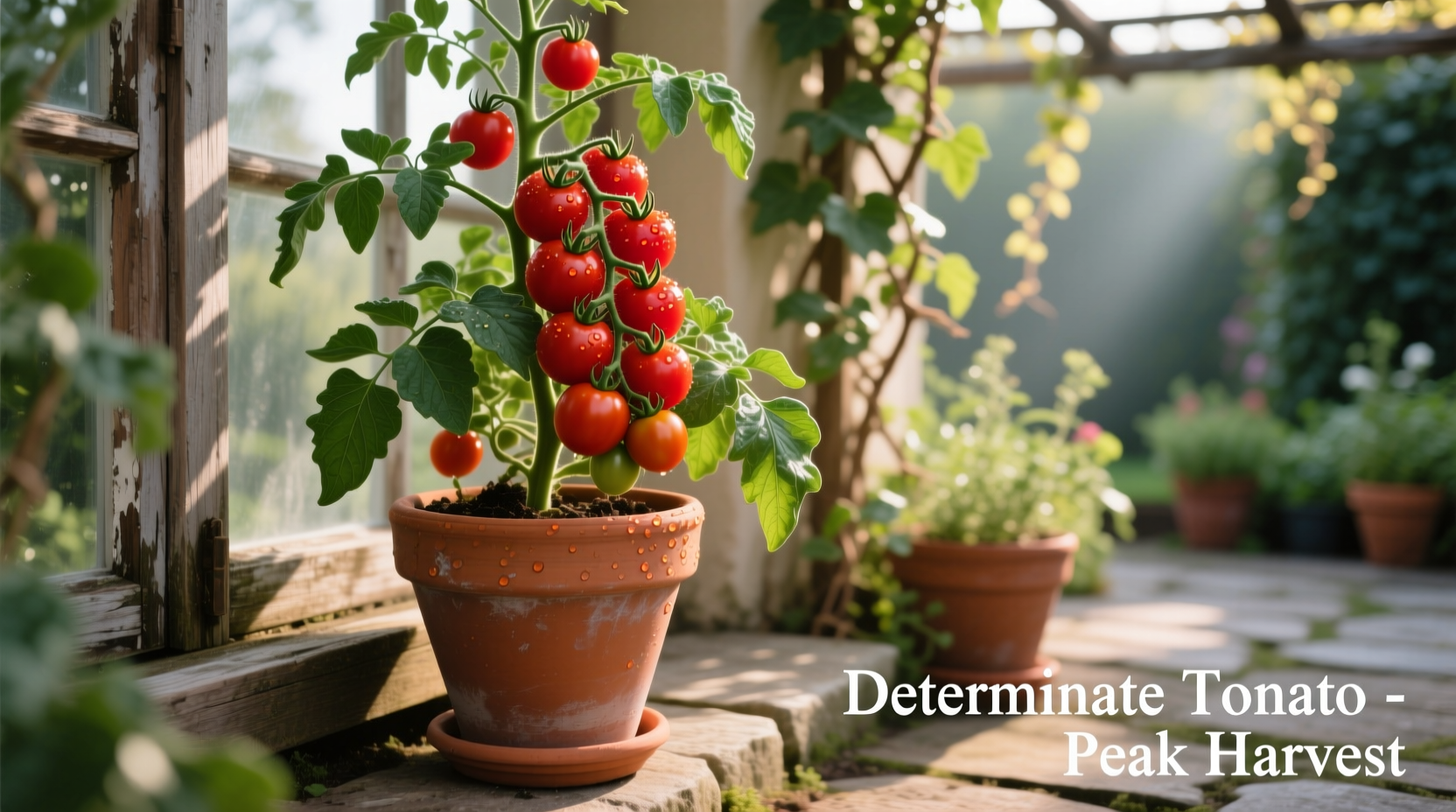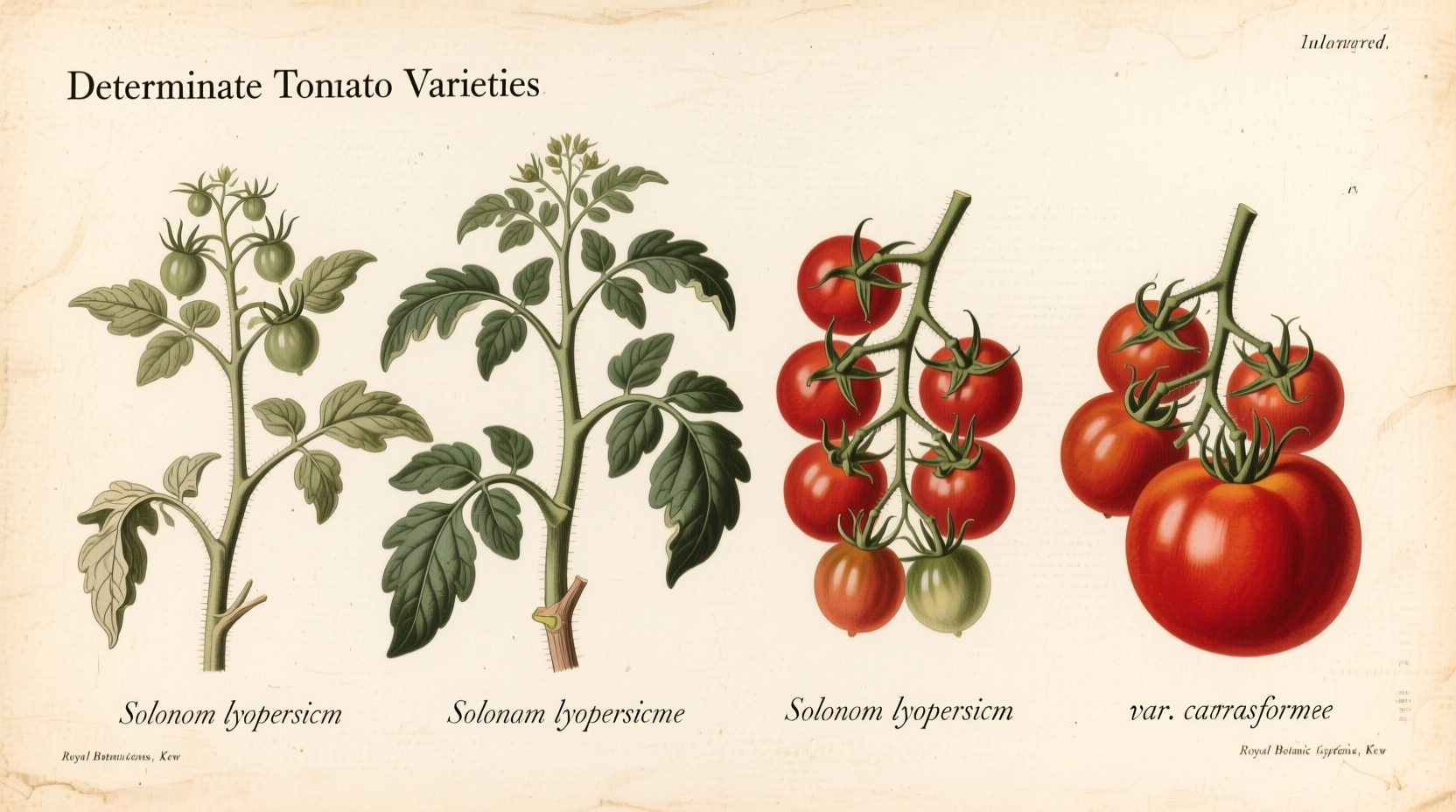Why Determinate Tomatoes Transform Small Space Gardening
For gardeners with limited space or container gardening needs, determinate tomato varieties offer game-changing advantages. Unlike their indeterminate cousins that grow like weeds all season, determinate tomatoes follow a precise biological blueprint that makes them perfect for controlled growing environments. Understanding these varieties helps you maximize yield without sacrificing precious garden real estate.
The Science Behind Determinate Growth Patterns
Determinate tomatoes (Solanum lycopersicum var. cerasiforme) possess a unique genetic trait called the "self-pruning" (sp) gene. This gene triggers the plant to stop vertical growth once it reaches maturity, typically after developing 5-6 fruit clusters. The result? A compact, bushy plant that directs energy into ripening a concentrated harvest rather than continuous vine growth.
According to horticultural research from University of Minnesota Extension, determinate varieties allocate approximately 70% of their energy to fruit production during their peak harvest window, compared to just 40% in indeterminate types during the same period. This biological efficiency makes them exceptionally productive for their size.
Determinate vs. Indeterminate: Critical Differences at a Glance
| Characteristic | Determinate Tomatoes | Indeterminate Tomatoes |
|---|---|---|
| Growth Habit | Bush-type, stops at 3-4 feet | Vining, continues growing 6-10+ feet |
| Harvest Period | Concentrated 4-6 week window | Continuous throughout season |
| Pruning Needs | Minimal (only remove diseased leaves) | Regular pruning required |
| Staking Requirements | Light support (cages work well) | Heavy staking/trellising needed |
| Best For | Containers, small gardens, canning | Continuous fresh eating, large gardens |
Top 8 Determinate Tomato Varieties for Home Gardeners
When selecting determinate varieties, consider your primary use case. Here's what agricultural specialists from The Old Farmer's Almanac recommend based on specific gardening needs:
- Roma VF - The canning champion with thick-walled, oval fruits ideal for sauces (75 days to harvest)
- Celebrity - Disease-resistant all-rounder producing 7-8 oz red fruits perfect for slicing (70 days)
- Bush Early Girl - Fastest maturing determinate (59 days) for short-season climates
- Patio Princess - Specifically bred for containers, reaches only 14-18 inches tall
- Amish Paste - Heirloom determinate with exceptional flavor for sauces (80 days)
- Mountain Merit - Crack-resistant globe tomatoes ideal for fresh eating (72 days)
- Fourth of July - Early producer with 3-4 oz fruits ready by Independence Day in warm climates
- San Marzano - Italian plum tomato with intense flavor, perfect for authentic sauces (78 days)

Optimizing Your Determinate Tomato Harvest
While determinate varieties require less maintenance than indeterminates, proper technique maximizes your yield. The Oregon State University Extension Service recommends these evidence-based practices:
Planting Strategy
Space plants 24-36 inches apart (vs. 36-48 for indeterminates) since they won't spread as much. Plant deeper than indeterminate varieties—bury up to two-thirds of the stem—as determinates readily develop roots along the buried portion, creating stronger root systems.
Fertilization Timing
Apply balanced fertilizer (10-10-10) at planting, then switch to low-nitrogen, high-phosphorus formula (5-10-5) once flowers appear. Determinates need less nitrogen overall since they're not supporting continuous vine growth. Over-fertilizing with nitrogen leads to excessive foliage at the expense of fruit production.
Water Management
Maintain consistent moisture, especially during fruit set. Determinates are particularly vulnerable to blossom end rot during inconsistent watering due to their concentrated fruit production. Mulch heavily to maintain soil moisture levels—straw works exceptionally well for these compact plants.
Avoid These 3 Common Determinate Tomato Mistakes
Even experienced gardeners make these errors with determinate varieties:
- Over-pruning - Unlike indeterminates, determinates shouldn't be pruned beyond removing diseased or damaged leaves. Each pruning cut removes potential fruiting sites since they don't produce new growth.
- Incorrect staking - Using flimsy supports that can't handle the concentrated weight of ripening fruit. Determinates produce heavy fruit loads all at once, requiring sturdy cages (minimum 5-foot height).
- Planting too late - Since determinates have a fixed harvest window, planting after your region's optimal date means missing the entire harvest period. Calculate backward from your first frost date using days-to-maturity information.
When Determinate Tomatoes Shine: Contextual Applications
Determinate varieties excel in specific gardening scenarios but may disappoint in others. Based on field research from Gardener's Supply Company, these are the ideal use cases:
- Container gardening - Varieties like Patio Princess thrive in 5-gallon containers where space is limited
- Short-season climates - Early-maturing determinates (Bush Early Girl) outperform indeterminates in northern zones
- Canning operations - The concentrated harvest of Romas simplifies large-batch sauce making
- Urban balconies and patios - Compact growth habit fits small outdoor spaces
- School gardens - Predictable harvest timing aligns with academic calendars
Conversely, determinates aren't ideal if you want continuous fresh tomatoes throughout summer or have ample garden space where indeterminates' higher total yield would be advantageous.
Maximizing Your Determinate Tomato Success
By understanding the unique growth patterns and requirements of determinate tomato varieties, you can strategically select and cultivate these compact powerhouses for maximum productivity. Remember that their concentrated harvest window is both their greatest strength and limitation—plan your garden accordingly by staggering plantings or combining with a few indeterminate varieties for continuous fresh tomatoes.











 浙公网安备
33010002000092号
浙公网安备
33010002000092号 浙B2-20120091-4
浙B2-20120091-4